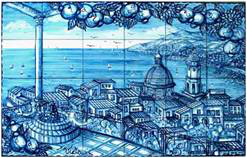Speaker
Ms
Ani Asatryan
(Institute of Hydroponics Problems, NAS RA)
Description
Since 1996 we have carried out radiomonitoring researches in water-soil-plant ecosystems in zones of the Armenian NPP (ANPP) with a radius of 2-15 km and 30km (surroundings of IHP, Yerevan). ANPP is in a densely populated area of the Ararat Valley with intensive agriculture (there are 64 villages and 3 towns in 2-15km radius zone of the ANPP).
The Ararat Valley is in the south-west of Armenia, 850-900m above sea level and is distinguished by hot dry climate conditions and precipitation is 300-350mm with intensive agriculture.
The aim of the studies is to reveal the peculiarities of migration and accumulation of controlled artificial radionuclides (ARN, 90Sr, 137Cs) in water-soil-plant system of agrocenosis and to develop activities based on them for getting radio-ecologically safe agricultural products. Since 2011, the radiomonitoring investigations have been implemented in the context of project 11-1f262.
The results of investigations have shown that natural waters, grey carbon soils and different plants in 2-15km radius zone of the ANPP exceeded the ones in 30 km radius zone with content of ARN.
Here is the list of natural waters in the vicinity of the ANPP according to content of ARN: Akna Lake>Metsamor River>drinking water. The drinking water of the ANPP exceeds that of IHP with content of 90Sr 1.8 times and the water of the Metsamor River exceeds 1.4 times the water of the Hrazdan River which flows through the territory of IHP. According to data of 1996-2011 the content of 90Sr exceeded the content of 137Cs in natural waters of the three studied zones. So, according to data of 2011 90Sr exceeded 137Cs 9.4 times in artesian water of the ANPP; 9.0 times in the River Metsamor, 12.2 times in Lake Akna; 5.0 times in artesian water of IHP; 7.1 times in the River Hrazdan.
The soils (0-30cm) in the vicinity of the ANPP exceed the soils of IHP with content of 90Sr and 137Cs 1.8 and 1.4 times. The distribution of ARN in both zones depends on the depth of soil layer. The maximum content of ARN is in the upper 0-10cm of the soil layer.
It turned out that the plants (the grass 1.5;1.2 times, the leaves of thuja-1.7; 1.2 times, the leaves of oak- 1.5; 1.3 times) and fruits (mulberry-1.2; 1.4 times, apricot-1.4-1.6 times) grown in the vicinity of the ANPP exceeded the indices of IHP with content of 90Sr and 137Cs. In the vicinity of ANPP mulberry, apricot, the leaves of thuja and oak exceeded the same indices of the IHP with β sum activity 1.3;1.1; 1.2 times.
Author
Mrs
Laura Ghalachyan
(Institute of Hydroponics Problems, NAS RA)
Co-authors
Mrs
Anahit Aristakesyan
(Institute of Hydroponics Problems, NAS RA)
Ms
Ani Asatryan
(Institute of Hydroponics Problems, NAS RA)
Mrs
Katush Qocharyan
(Institute of Hydroponics Problems, NAS RA)
Mrs
Lusik Tadevosyan
(Institute of Hydroponics Problems, NAS RA)

